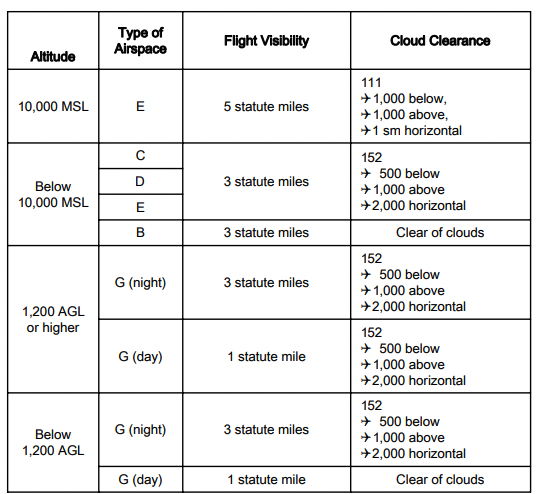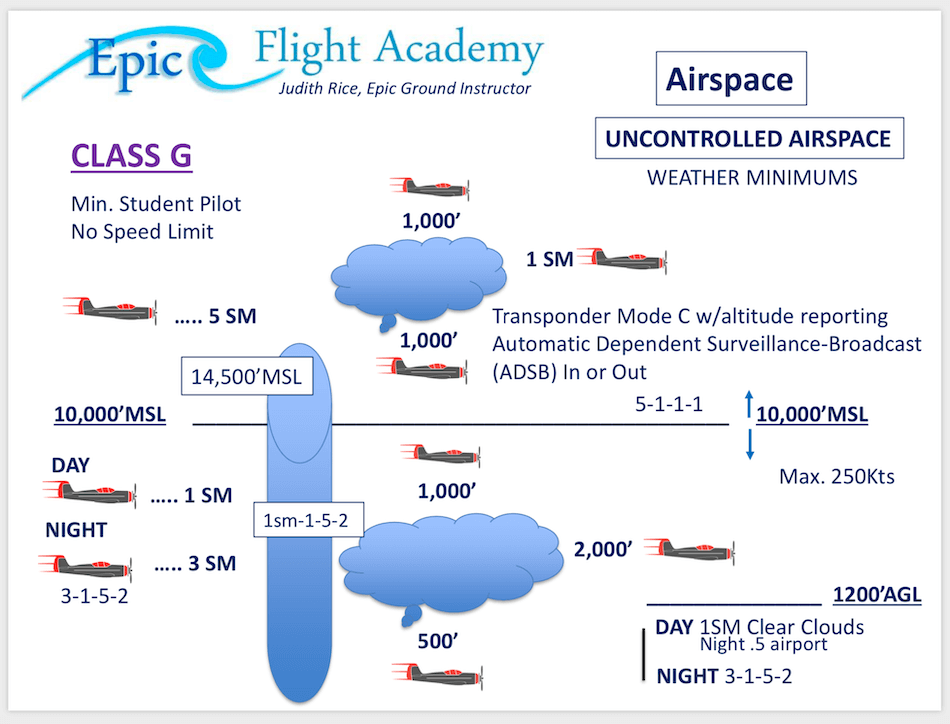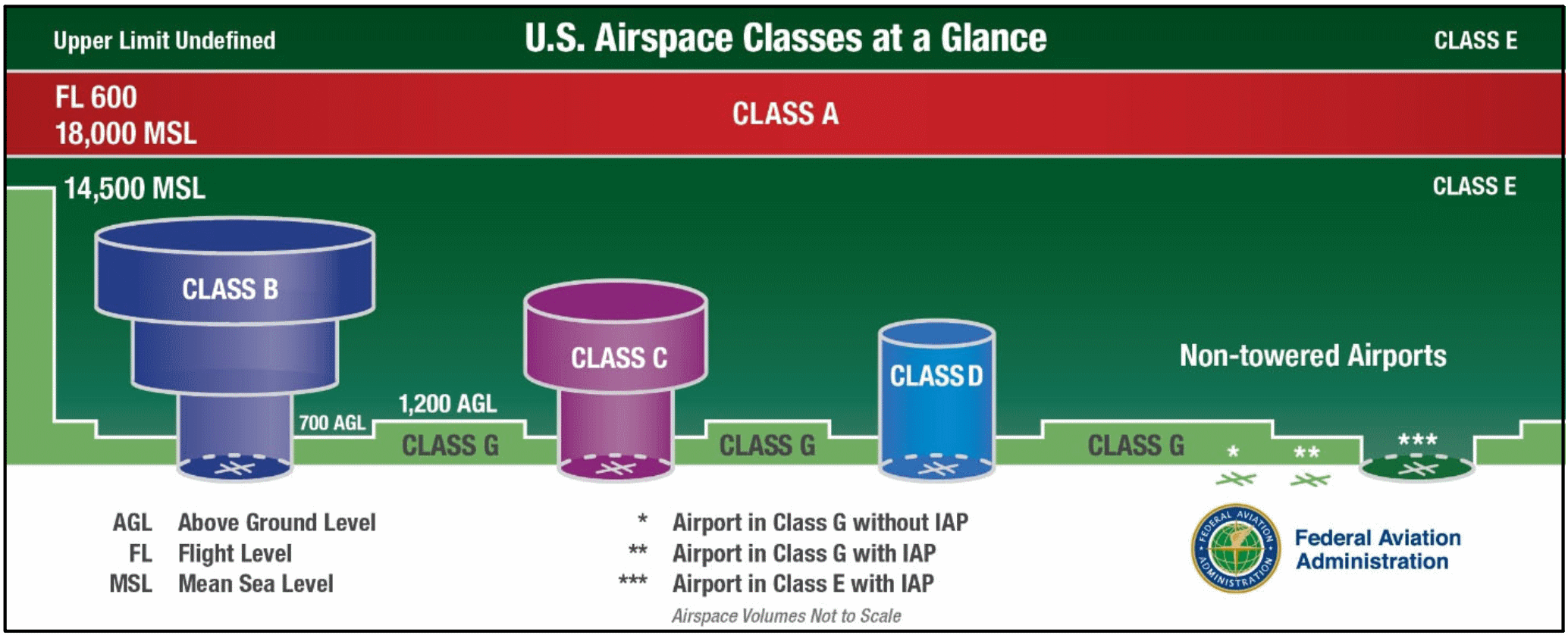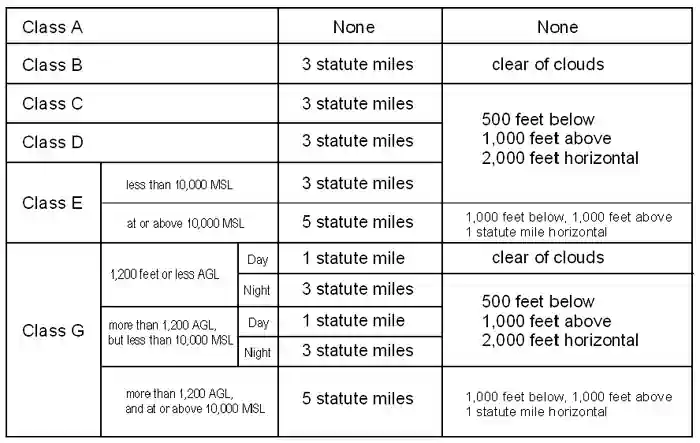class g airspace weather minimums
Here is what to know. 3sm visibility 1000 above clouds 500 below clouds and at least 2000 horizontal from clouds.

Helicopter Instrument Procedures Part Three
1200 ft AGL or Below Day.
. Rules governing VFR flight have been adopted to assist the pilot in meeting the responsibility to see and avoid other aircraft. Day except as provided in 91155b 1 statute mile. Depending on how high you fly and the time of day within Class G airspace your visibility requirement could range anywhere from 1SM to 5SM.
There are a few nuances here so pay attention. Class A NO VFR. Visibility requirement 3 statute miles.
Class G Airspace Weather Visibility Requirements. The VFR weather minimums are the same as Class C airspace 3 SM with a ceiling of at least 1000ft and cloud clearance of 1000ft above 500ft below and 2000ft horizontally. The weather minimums in Class G airspace vary based on altitude whether it is day or night and proximity to an airport.
VFR minimums at night below 10000 msl but higher than 1200 above the surface agl are. A Unless otherwise specified in the certificate holders operations specifications when conducting VFR helicopter air ambulance operations in Class G airspace the weather minimums in the following table apply. 1200 ft AGL or Below Night.
A Unless otherwise specified in the certificate holders operations specifications when conducting VFR helicopter air ambulance operations in Class G airspace the weather minimums in the following table apply. 1 1200 feet AGL and lower. Lets break the minimums down into three major categories.
1 statute mile visibility and clear of clouds. Class C airspace and Class D airspace are lumped together because the requirements are identical See Figure 4. 36 rows Class G.
Class CDE below 10KG below 10K at night. To fly in Class G airspace you will need a minimum of a student pilot certificate. Class G 1200 feet or less above the surface regardless of MSL altitude.
135609 VFR ceiling and visibility requirements for Class G airspace. For aircraft other than helicopters. Day except as provided in 91155 b 1 statute mile.
Night except as provided in 91155 b 3 statute miles. Class G Is The Most Lenient And Confusing. Generally Class G airspace extends up to the floor of Class E airspace up to 14500ft MSL.
Class G 1200 below 10K day. 12 rows VFR Minimum Visibility Below 10000 MSL. Class G minimum weather requirements exist so that you can see and avoid other aircraft and stay out of the clouds.
When flying into an airport in Class G airspace communications should be established prior to 4 NM from the airport up to and including 2500 AGL. VFR Minimum Distance from Clouds Below 10000 MSL. I guess what I am asking is if there is an airport that is Class G at the surface outside of any other airspace where does the Class G end and where does the Class E begin.
A Unless otherwise specified in the certificate holders operations specifications when conducting VFR helicopter air ambulance operations in Class G airspace the weather minimums in the following table apply. The Flight Visibility minimums for both are. A helicopter may be operated clear of clouds in an airport traffic pattern within 12 mile of the runway or helipad of intended landing if the flight visibility is not less than 12 statute mile.
1200ft or less above the surface regardless of MSL altitude Day. CFR US. Class G airspace uncontrolled is that portion of airspace that has not been designated as Class A Class B Class C Class D or Class E airspace.
Weather Minimums in Class G Airspace. Class B 3 CoC. Cloud clearances range from clear of clouds to 1SM There are 6 sets of Class G weather minimums associated with various altitudes during the day or night.
500 Below 1000 Above 2000 Horizontal. 500 Below 1000 Above 2000 Horizontal 500 Below. There is no formal separation is provided so each pilot is responsible to see and avoid other traffic.
1200 feet or less above the surface regardless of MSL altitude For aircraft other than helicopters. Related Article Special VFR Clearance Explained. Distance from clouds requirement Clear of clouds.
135609 VFR ceiling and visibility requirements for Class G airspace. Cloud clearance minimums of 1000 feet above 1000 feet below and 2000 feet horizontally. Day - 1 Statute Mile Night - 3 Statute Miles.
The standard basic VFR weather minimums at night in. Minimum flight visibility and distance from clouds required for VFR flight are contained in 14. 3 In Class G airspace IFR departures with visual transitions are authorized only after the pilot in command determines that the weather conditions at the departure point are at or above takeoff minimums depicted in a published departure procedure or VFR minimum ceilings and visibilities in accordance with 135609.
Class E airspace is controlled airspace which is not Class A B C or D. 6 days ago 36 rows 91155 Basic VFR 36 rows 91155 Basic VFR. Visibility requirement 1 statute mile.
500 feet below 1000 feet above 2000 feet horizontal. 36 rows Notwithstanding the provisions of paragraph a of this section the following operations may be conducted in Class G airspace below 1200 feet above the surface. Day ½ statute mile.
G night 3 statute miles 152 4500 below 41000 above 42000 horizontal G day 1 statute mile 152 4500 below 41000 above 42000 horizontal G night 3 statute miles 152 4500 below 41000 above 42000 horizontal G day 1 statute mile Clear of clouds Below 1200 AGL 1200 AGL or higher 3 statute miles 152 4500 below 41000 above 42000 horizontal Below 10000 MSL. These minimums cover most Class G airspace but are only valid during the daytime when you are within 1200 agl of the surface. Class G 1200 or less day.
14 CFR 91155 - Basic VFR weather minimums. Class G Uncontrolled Class G is considered uncontrolled airspace but still has VFR weather minimums. Although Class G is uncontrolled it is also subject to the most weather restrictions based on where the airspace is located.
I am looking at the weather requirements for Class G operations and I cant seem to find an airport or airspace that would be Class G above 1200 feet. 500 Below 1000 Above 2000 Horizontal. Actually after looking at this I think we can make this easier.
Night except as provided in 91155b 3 statute miles. To help with that Ive created a stripped down mnemonic of each airspace and its corresponding vfr weather minimums. 10000 feet MSL or higher 5 sm visibility.
How To Remember Vfr Weather Minimums Bobbie Lind
What Are The Basic Vfr Minimums Quora
How To Remember Vfr Weather Minimums Bobbie Lind

Airspace Visibility Requirements Diagram Quizlet
Regulations Vfr Minimums Learn To Fly Blog Asa Aviation Supplies Academics Inc
How To Remember Vfr Weather Minimums Bobbie Lind

Ifr Vs Vfr In Aviation Understanding The Differences Pilot Institute

Why Are There Mandatory Cloud Clearance Requirements Boldmethod
Vfr Weather Minimums Cancel Ifr Darren Smith Flight Instructor Cfi Homepage
How To Remember Vfr Weather Minimums Bobbie Lind

Faa Airspace For Vfr Flight Youtube

Pa I E S1 Vfr Weather Minimums Youtube

Airspace Classes And Special Use Airspace Everything There Is To Know



